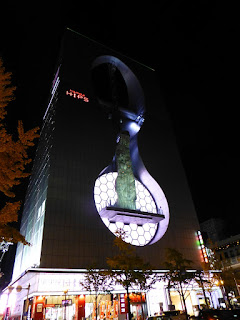United offers non-stop flights form SFO to the Kansai Airport. However, the prices are significantly more than the fares to Tokyo. And the long-distance trains in Japan are very dependable. So, I opted to fly into Tokyo and then catch the trains directly to Osaka. I purchased a rail pass before leaving to help keep things simple. At a Japanese travel agency, I purchased a Japan Rail (JR) rail pass voucher with the options I wanted. You can buy a pass good for 7, 14, or 21 days. You can buy one for the regular coaches or for the green (reservation-only) coaches. And you can buy either a regional or country-wide pass. Since I was going to cross regions (Eastern Japan to Western Japan), I needed the full-country pass. I opted for the green car upgrade, where the coaches tend to be less crowded, although the pass allows you access to the non-reserved coaches as well.
Upon landing at Narita Airport in Tokyo, I cleared immigration and customs and headed to the JR Travel Desk (where there was a little line) so I could exchange my voucher for a pass. They also booked my reservations for continuing on my journey to Osaka. This involved taking a Narita Airport Express train to Central Tokyo (about an hour ride) and then changing trains at Shinagawa station for the Shinkansen bullet train to Osaka (20-minute layover). The rail pass lets you ride any JR train except the Nozomi and and Mizuho trains (the super express trains with minimal stops--between Tokyo and Osaka, it only makes about a 15-minute difference in travel time). The Narita Airport Express train I took was pretty uncrowded in the green car. My Shinkansen train's green car had surprisingly more people. My flight was about an hour late, but the trains are so frequent that it did not pose any problems. From airport to hotel (which also involved a subway ride) took about 4.5 hours.
The St. Regis located in the central part of Osaka. The rooms are comfortable and calming.
The Japanese-style shower room was behind a glass door and wall. I like these shower rooms because there is a nice deep-soaking tub with a lot of space for showering. My American Express Fine Hotels and Resorts package included a nice buffet and cook-to-order breakfast, as well as one formal afternoon tea in the bar.
For my first two days, I planned on exploring Osaka proper. I visited Osaka Castle, the observation deck of a very interesting modern building, the Ceramics museum, and a temple area. I was aided by a two-day Osaka tourist pass, which gave me free access to all public transportation within the city and and free or discounted admission to selected attractions and museums.
 |
| View from Osaka Castle top |
 |
| Floating Garden Observatory |
 |
| Floating Garden Observatory at the top |
I also visited the Dotonburi area, several blocks of restaurants and shopping centered around a canal.

One evening, I went to a 2-star Michelin restaurant called Fujiya 1935, a molecular cuisine restaurant I had found out about and managed to make a reservation for my visit.
On my final full day in the area, I took a train ride out to Nara (thanks to my JR rail pass). Nara was the first capital of Japan and has many treasured temple areas, as well as the famous deer that are allowed to roam essentially unhindered in the park area.
In a separate section of Nara, partway back towards Osaka and a little hike from the train station, is a collection of the oldest wooden structures in the world at the temple complex called Horyuji.
I also visited a restaurant called XEX West in Osaka near the main train station. Because I had taken advantage of my free afternoon tea earlier, I only ordered a few small plates for dinner.
 |
| Vegetable and tofu salad |
 |
| Shrimp and avocado |
 |
| Miso grilled local chicken |
 |
| Stewed orange and sweet potato with sweet potato gelato |
After some airport shopping and some food in the First Class Lounge, I boarded my plane for an on-time departure back to SFO.




















No comments:
Post a Comment